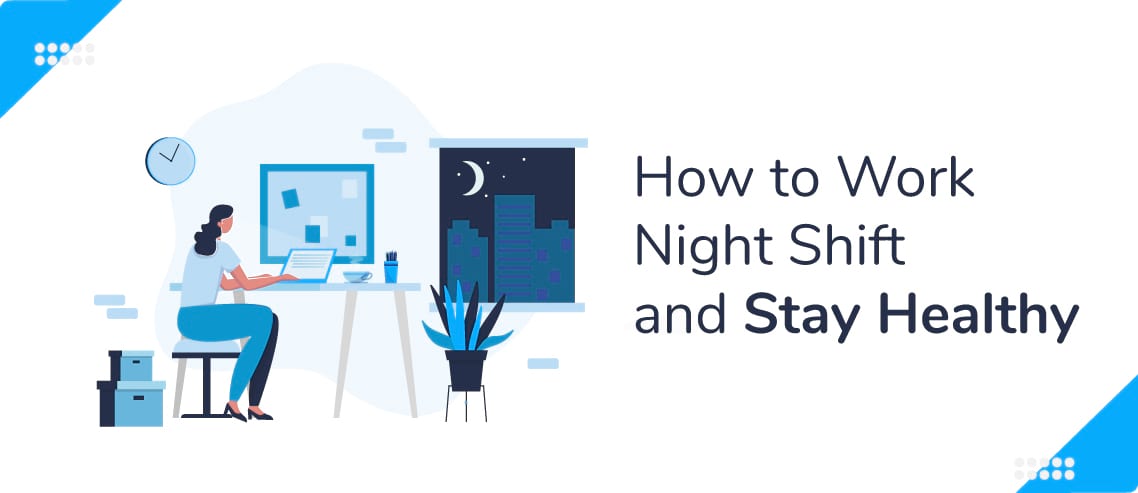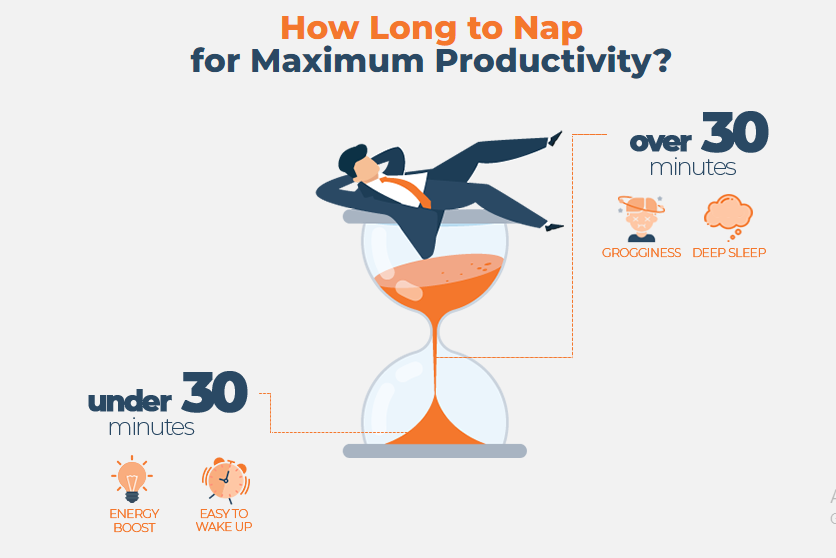How to Work Night Shift and Stay Healthy

If you’re one of America’s 15 million night shift workers, you may face the well-known challenge of creating and maintaining a healthy routine. For all the benefits of working night shift, it can be tricky to establish a routine that allows you to get sufficient sleep, nutrition, and exercise.
Let’s take a deep dive into how to work night shift and stay healthy at the same time with our top tips for working night shift.
Why it’s important to stay healthy on a night shift
The human body is governed by an in-built circadian rhythm that tells us when to be active and when to rest. This natural schedule helps us to map out our day and night and determines how our digestive system, body temperature, and heart rates are regulated.
Most people work during the day when we’re naturally prepped for activity. By contrast, night shifts go against the biological grain, and can disrupt the body’s pattern. While there are many benefits of working night shift, this disruption can be difficult to overcome.
As such, it’s crucial that night shift workers take extra steps to manage their health and avoid issues that are linked to night workers, such as diabetes, heart disease, weight gain and even mental health issues. That said, if the right steps are taken, there’s no reason why night shift workers cannot live healthily and happily in their schedules.
Top tips for working night shift and staying healthy
1. Cluster shifts together
Where possible, it’s worth trying to cluster your shifts so that your body gets used to your schedule. Rotating shifts can be extremely difficult to adjust to, and may lead to constant tiredness as your body plays catch-up with the changing pattern.
While it’s not always easy to determine your shift pattern, make sure you use your last day off to stay up as late as possible to get ready for your first night shift.
2. Eat nutritious meals
Many shift workers fall into the understandable trap of snacking to stay awake or grabbing fast food – meals that are readily available at all hours. It stands to reason that this may be why night shift work has been correlated with increased metabolic issues, such as diabetes and heart disease.
To stay healthy, prepare your meals in advance to make sure you’re eating a solid three meals during your wake hours. Include plenty of protein, as well as green leafy vegetables. For your shift, pack healthy snacks, such as high-protein energy bars, rather than sugary treats that will give you a spike in energy followed by a slump.
3. Stay hydrated
Eating healthily goes hand in hand with keeping your hydration levels up. Try and stick to water rather than the high-sugar sodas, so that your body stays regulated as well as possible.
Ideally, aim to drink 12-16 cups of water per day to ensure nutrients are delivered to cells, your organs are kept functional, and your body temperature is maintained.
4. Prioritize sleep
Sleep is your body and mind’s natural way of repairing itself. That said, the night shift worker’s challenge is that when they’re trying to sleep, their friends and family are arranging social gatherings that can be hard to turn down.
Keep focused on the reasons why you need to stick to your schedule and the importance of rest. Sleep deprivation is proven to have serious implications for your health and well-being, both in the short and long term.
5. Practice good sleep hygiene
In order to prioritize sleep, you need to find the right techniques to ensure you maximize sleep when you get it. This can start with creating an environment that’s conducive to a restful night’s sleep with items such as blackout blinds, ear plugs, comfortable sheets and blankets.
Next, establish a routine that helps support your sleep. This may include a soak in the bath before bed, a screen and blue light ban an hour before scheduled sleep, reading a good book, running a white noise machine and wearing an eye mask. All these things can help to maintain good sleep hygiene so that your body and mind know when it’s time to rest.
6. Exercise
One of the best tips for working the night shift and staying healthy is to prioritize exercise. As already discussed, night shift work may increase your chance of becoming overweight, and developing heart disease and diabetes. To help fight against these risks, you need to establish a consistent exercise program.
Find a workout regime that you enjoy and preferably one that involves both cardio and strength training. Make sure it’s something that you can do consistently, even if it’s just ten minutes per day.
7. Watch your caffeine and sugar intake
When working night shifts, it’s easy to reach for caffeine and sugar to keep you going when energy levels dip. And there are proven benefits to caffeine; caffeine can improve your mental and physical health, when consumed in moderation.
Too much sugar can be catastrophic to your well-being, as it plays havoc with your energy levels and insulin production throughout the day. Caffeine too, when consumed in excess, can lead to slumps in energy, poor quality sleep and longer term health complications.
Instead, prioritize whole food snacks rather than sugary treats, and drink mainly water, particularly as you’re nearing your sleep window.
8. Develop a routine
Given that you’re working against your natural circadian rhythm, it’s paramount to manufacture a routine that keeps you on track. Set out your 24 hours to include enough time for sleep, for self-care, for meals, and for socializing, as well as your mandatory tasks such as housework and shopping.
9. Avoid alcohol
It’s tempting to use alcohol as a sleep aid, even if it’s just a glass or two of wine. The problem is that alcohol will almost certainly disrupt your REM sleep – the sleep you need to ensure you’re refreshed and ready for the day (or night) ahead!
10. Nap (wisely!)
Not everyone is a nap type of person, but if you love a good nap, one of the benefits of working night shift is the ability to recharge before your shift.

A word of warning, however: Be careful about when you nap and for how long. Keep your nap to no more than 30 minutes and avoid napping too close to your bedtime. You may work at a place that already supports employees with naps, but if you don’t, consider suggesting a nap space as an idea to your HR or management team.
11. Get some sun and/or dose up on vitamin D
For those who sleep during the day and work overnight, vitamin D deficiency can be an issue. Vitamin D, responsible for ensuring healthy bones and muscles, is absorbed via daylight and found in green leafy vegetables. Without it, loss of bone density, osteoporosis and osteomalacia (excruciating bone pain) can occur.
If you’re simply unable to get enough daylight during the day, take a high dose vitamin D supplement to keep your bones healthy and strong.
12. Reach out to others working night shifts
When your schedule is different from the norm, it can feel isolating and lonely. But part of staying healthy is feeling like you’re part of a supportive community.
Reach out to your co-workers or other night shift professionals on online forums and share your experiences and challenges. If you’re wondering how to work night shift and stay healthy, odds are so are your fellow night shift workers! You may be able to call on them for advice on how to manage your schedule or you might even find yourself an exercise buddy to keep you motivated.
Bonus for managers
If you manage a team of shift workers and need help scheduling employees for night shifts, ZoomShift can help you streamline your work week with the well-being of your employees in mind.
With one simple drag-and-drop tool (no more spreadsheets!), you can schedule your team’s shifts in a visual way, so that you can spot any issues in real-time.
In addition, your employees have access to their shift schedules and can request shift swaps, can turn down shifts, or pick up shift offers, giving them full control of their work-life balance.
ZoomShift’s employee scheduling software keeps it all in one place.
- View employee availability, time offs, shift swaps, and events from one place.
- Create schedules by day, week, and month.
- Copy schedules weekly and apply-templates.
- Manage paid time off
- Export timesheet in one click
How ZoomShift Employee Scheduling Works
Try your hand at building a night shift in ZoomShift. It’ll take less time than you think, and it could double or triple your productivity while simultaneously boosting employee morale. It’s truly a win-win, make your employees work night shift and stay healthy!
JD enjoys teaching people how to use ZoomShift to save time spent on scheduling. He’s curious, likes learning new things everyday and playing the guitar (although it’s a work in progress).



